|
|
|
|
|
|
|
|
Visit India |
|
|
|
|
|
|
|
|
|
Thiksey Monastery |
|
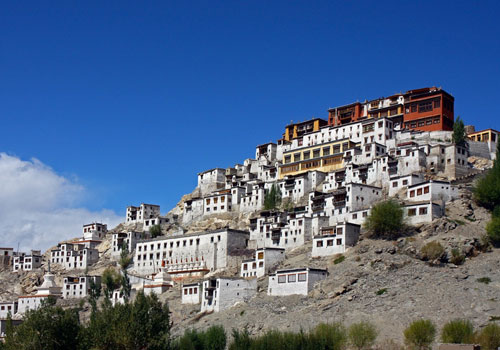 There is an interesting tale of the events that led to the building of Thiksey monastery: Jangsem Sherab Zangpo with his disciple Palden Sherab were performing a votive prayer services containing Tormas (ritual cake) to the local deities at lower part of a valley called Arzoo, which is about 3 km away from the present monastery. Suddenly a crow appeared and took away the ceremonial plate with Tormas in it. There is an interesting tale of the events that led to the building of Thiksey monastery: Jangsem Sherab Zangpo with his disciple Palden Sherab were performing a votive prayer services containing Tormas (ritual cake) to the local deities at lower part of a valley called Arzoo, which is about 3 km away from the present monastery. Suddenly a crow appeared and took away the ceremonial plate with Tormas in it.
On searching, they were amazed to find the plate with the Tormas in perfect order rested on top of a hillock.
The duo took it for an auspicious omen to build the monastery right there. The Tormas, even after the displacement, were found undisturbed or in “perfect order”, which gave the name of the monastery as Thiksey – meaning “In perfect order”.
The village where the monastery is situated is called Thiksey and the alternate name of the incumbent of the monastery is also addressed as Thiksey Rinpoche. |
|
|
Lamayuru Monastery |
|
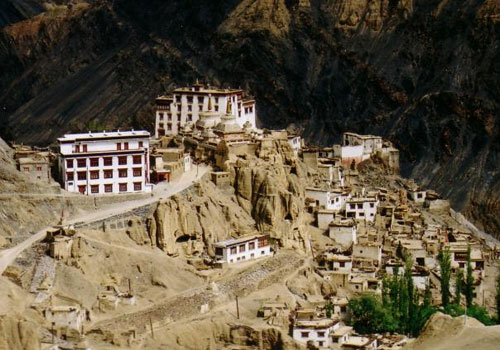 125 km west of Leh, Lamayuru monastery was founded in the 10th century. According to a popular folktale, Lamayuru was once a lake.
125 km west of Leh, Lamayuru monastery was founded in the 10th century. According to a popular folktale, Lamayuru was once a lake.
A Lama once blessed the place so that it caused the waters of the lake to recede up to the mountains and left the place for the monastery to be built.
This monastery is in utter ruins and only its main hall stands to this day housing numerous Tankhyas.
The Yundrung Kabgyad festival is held here annually during summer on the 28th and 29th days of the second Tibetan month. Lamayuru has some fascinating caves carved out of the mountainside and is set on a high cape overlooking the village and valley.
The monastery is also known as Yung Drung (meaning 'Swastika') and is worth seeing, if only for its beauty that surmounts that of any other gompa of the region.
|
|
|
Alchi Monastery |
|
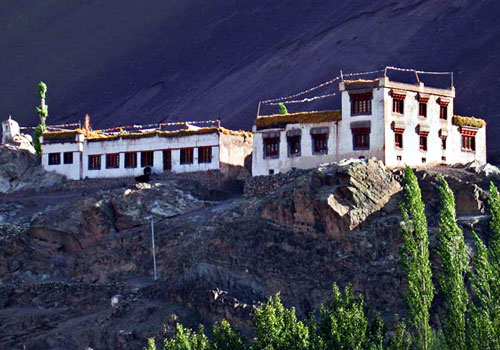 Around 67 km from Leh, a small village by the name of Alchi is home to one of the oldest monasteries in Ladakh region. Standing on the banks of river Indus, the monastery, Alchi Monastery, is also known by the name of Alchi Choskhor. T Around 67 km from Leh, a small village by the name of Alchi is home to one of the oldest monasteries in Ladakh region. Standing on the banks of river Indus, the monastery, Alchi Monastery, is also known by the name of Alchi Choskhor. T
Though traditionally, the credit for the construction of the monastery goes to the great translator Rinchen Zangpo (958-1055), the oldest monuments preserved here date back to the middle of the 12th century.
The significance of the monastery also lies in the fact that it is the only one that has been built on a flat ground. The monastery complex houses two main temples - Alchi Du-khang and the Sum-tsek. Apart from these, other smaller structures of the monastery complex include The Temple of Manjushri, Lotsawa Lha-khang, Lha-khang Soma and 3 Ka-ka-ni (entrance) chortens.
|
|
| Shanti Stupa |
|
 Shanti Stupa of Ladakh is located on the hilltop at Changspa. It can be reached quite easily from the Fort Road. The Stupa was constructed by a Japanese Buddhist organization, known as 'The Japanese for World Peace'. Shanti Stupa of Ladakh is located on the hilltop at Changspa. It can be reached quite easily from the Fort Road. The Stupa was constructed by a Japanese Buddhist organization, known as 'The Japanese for World Peace'.
The aim behind the Shanti Stupa construction of the stupa was to commemorate 2500 years of Buddhism and to promote World Peace. His Holiness, the Dalai Lama inaugurated the Shanti Stupa in the year 1985.
A magnificent white-domed structure, the Shanti Stupa of Leh Ladakh offers spectacular views of the sunrise and sunset.
The stupa looks best at night, when it is beautifully illuminated with glittering lights. A large number of tourists come to Ladakh every year to visit this amazing stupa. |
|
|
Hemis Monastery |
|
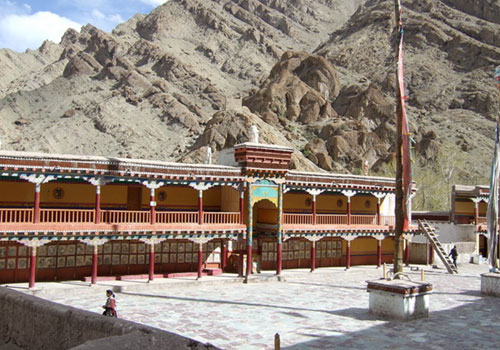 Hemis Monastery is the largest monastic institution in Ladakh. It belongs to the Drukpa Lineage or the Dragon Order of Mahayana Buddhism, with His Holiness the Gyalwang Drukpa as its supreme spiritual head.
Hemis Monastery is the largest monastic institution in Ladakh. It belongs to the Drukpa Lineage or the Dragon Order of Mahayana Buddhism, with His Holiness the Gyalwang Drukpa as its supreme spiritual head.
Gyalwa Gotsangpa Gonpo Dorje (1189-1258), a main disciple of the 1st Gyalwang Drukpa, Tsangpa Gyare Yeshe Dorje (1161-1211), and one of the most celebrated yogis in the Himalayas, came to Ladakh in the 13th century and established the Drukpa Lineage here.
Gyalwa Gotsangpa meditated in a cave on the edge of the mountain above Hemis Monastery, where a meditation centre named after him was established.
In the 17th century, the 1st Taktsang Repa, Ngawang Gyatso (1573-1651), popularly known as “Taktsang Shambunath” and also in Ladakhi language as “Staktsang Raspa”, who was another great Drukpa Lineage master, became the Royal Preceptor of the Kingdom of Ladakh and with the support of King Sengge Namgyal (1616-1645), he founded the Hemis Monastery. |
|
|
Diskit Monastery |
|
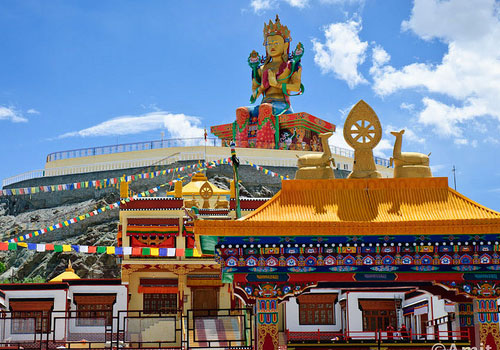 Diskit in Ladakh region of Jammu and Kashmir is famous for its 14th century monastery, believed to be the largest and oldest monastery in Nubra valley.
Diskit in Ladakh region of Jammu and Kashmir is famous for its 14th century monastery, believed to be the largest and oldest monastery in Nubra valley.
Diskit is situated at an altitude of 10,310 ft above sea level, at the edge of desert on Shyok valley. Among the larger villages, Diskit is the administrative centre of Nubra valley.
The valley was an important stopover on the caravan route between Tibet and China.
The monastery belongs to Gelugpa order or the Yellow Hat sect of Tibetan Buddhsim. It was founded by Changzem Tserab Zangpo, the disciple of Tsong Khapa, in 14th century.
|
|
|
Spituk Monastery |
|
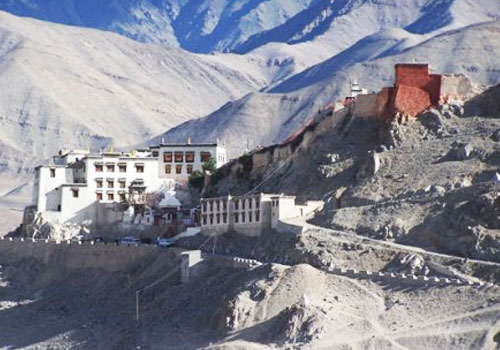 9 Km from Leh, the monastery standing on a conical hill with 3 chapels was founded in the 11th, century by Od-de the elder brother of Lha Lama Changchub Od, when he came to Maryul. He introduced a monastic community. When Rinchen Zangpo, the translator came to that place he said that an exemplary religious community would arise there and so the monastery was called Spituk (Exemplary). That time it belonged to the Kadampa School.
Then during the lifetime of Dharmaraja Tagspa Bum- Lde Lama Lhawang Lotus restored the monastery and the stainless order of Tsongkhapa was introduced and it has remained intact as such up till the present. The Principal statue is that of the lord Buddha. Within this status there is a sacred image of Amitayus, about the finger size, presented to King Tagspa Bum-Lde by the great Tsongkhapa. Every year from the 27th, to 29th, days of the Tibetan 11th, month the sacred dance associated with the festival of the Gustor are held. Stok Monastery, Sankar monastery and Saboo monastery are branches of Spituk Monastery. The incumbents of all these monasteries are the successive reincarnations of Skyabsje Bakula Rinpoche. The monastery belongs to Gelugpa order. There are about 150 monks in the monastery of Spituk. 9 Km from Leh, the monastery standing on a conical hill with 3 chapels was founded in the 11th, century by Od-de the elder brother of Lha Lama Changchub Od, when he came to Maryul. He introduced a monastic community. When Rinchen Zangpo, the translator came to that place he said that an exemplary religious community would arise there and so the monastery was called Spituk (Exemplary). That time it belonged to the Kadampa School.
Then during the lifetime of Dharmaraja Tagspa Bum- Lde Lama Lhawang Lotus restored the monastery and the stainless order of Tsongkhapa was introduced and it has remained intact as such up till the present. The Principal statue is that of the lord Buddha. Within this status there is a sacred image of Amitayus, about the finger size, presented to King Tagspa Bum-Lde by the great Tsongkhapa. Every year from the 27th, to 29th, days of the Tibetan 11th, month the sacred dance associated with the festival of the Gustor are held. Stok Monastery, Sankar monastery and Saboo monastery are branches of Spituk Monastery. The incumbents of all these monasteries are the successive reincarnations of Skyabsje Bakula Rinpoche. The monastery belongs to Gelugpa order. There are about 150 monks in the monastery of Spituk. |
|
|
Zangla Monastery |
|
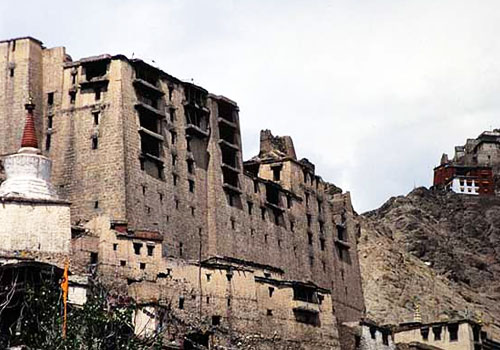 Lying deep in the northern arm of Zanskar at the end of the 35 km long road from Padum, Zangla was being ruled by a titular king till his death a few years back. The old castle now in ruins except for a small chappel, occupies a hill, overlooking the desertic valley below. Nearby is the old nunnery worth a visit for the austere life style of the small monastic community of nuns. An old monastery situated in the nearby village of Tsa-zar has exquisite frescos. Lying deep in the northern arm of Zanskar at the end of the 35 km long road from Padum, Zangla was being ruled by a titular king till his death a few years back. The old castle now in ruins except for a small chappel, occupies a hill, overlooking the desertic valley below. Nearby is the old nunnery worth a visit for the austere life style of the small monastic community of nuns. An old monastery situated in the nearby village of Tsa-zar has exquisite frescos.
The village lies mid-way between Stongdey and Zangla. Zangla is the nodal point on the popular Padum-Strongdey-Zangla-Karsha-Padum round trip, which covers most of the cultural sites of Zanskar. The river is now crossed by a temporary foot-bridge for approaching the left bank along which the trail to Karsha follows. Zangla is also the take-off point for the Padum-Markha valley treks.
|
|
|
Phyang Monastery |
|
 The Phyang monastery is located around 6 km away from the Srinagar-Leh highway and around 20 kms. from Leh, the capital of Ladakh. The Phyang Gompa (Monastery) is a traditional monastery of Ladakh and is famous for its spectacular religious festival with masked dances. This monastery being on the hilltop resembles quite like the monastery of Likir. The Phyang Monastery was built in the 16th century and belongs to the Red Cap sect. The festival of Phyang is called Tseruk' and falls on the 2nd and 3rd
day of the 6th month of Tibetan Calendar. The Phyang Monastery was the first monastery, which introduced the Degungpa teaching of 'Skyob Jigsten Gonbo' in Ladakh. These teaching were introduced by Chosje Danma Kunga, during 16th century AD as King Jamyang Namgyal ruled. Another attraction of Phyang is the museum. This ancient 900 years old museum has a spectacular collection of Chinese, Tibetan and Mongolian articles including fire arms and weapons. After a recent renovation the monastery is worth visiting. Travellers can also make a visit to the Phyang lake just a few kilometers away. The Phyang monastery is located around 6 km away from the Srinagar-Leh highway and around 20 kms. from Leh, the capital of Ladakh. The Phyang Gompa (Monastery) is a traditional monastery of Ladakh and is famous for its spectacular religious festival with masked dances. This monastery being on the hilltop resembles quite like the monastery of Likir. The Phyang Monastery was built in the 16th century and belongs to the Red Cap sect. The festival of Phyang is called Tseruk' and falls on the 2nd and 3rd
day of the 6th month of Tibetan Calendar. The Phyang Monastery was the first monastery, which introduced the Degungpa teaching of 'Skyob Jigsten Gonbo' in Ladakh. These teaching were introduced by Chosje Danma Kunga, during 16th century AD as King Jamyang Namgyal ruled. Another attraction of Phyang is the museum. This ancient 900 years old museum has a spectacular collection of Chinese, Tibetan and Mongolian articles including fire arms and weapons. After a recent renovation the monastery is worth visiting. Travellers can also make a visit to the Phyang lake just a few kilometers away.
|
|
|
|
Scroll
|
|
|
|
 |
|
|
